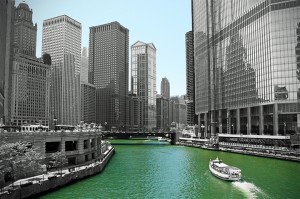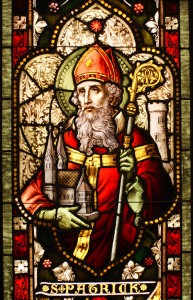Celebrating St Patrick’s Day
St. Patrick’s Day Parade in San Francisco. Photo by David Yu via Flickr
St. Patrick’s Day is the day when we be wearin’ the green, walking up and down streets drinkin’ and actin’ the fools — and some might even participate in a parade. My grandmother on my mother’s side was part Irish so my parents thought there should be one Irishman in the family and gave me the middle name of Patrick. True story. Then the old man took to introducing me as Timothy Patrick O’Forkes — it has a nice lilt to it.

(Photo via Wikipedia)
It’s a drinking day, an excuse — no a mandate — to get out in the clubs and get so drunk our eyeballs hurt the next morning. Professional drunks refer to St. Patrick’s Day as amateur night.
The stereotype of the Irish being a drunken lot, well that’s perpetrated by the Irish in many cases. It started though in the 19th Century after the Irish Catholics arrived as immigrants and participated in the many St. Patrick’s Day parades that took place around the country. Newspaper political cartoons portrayed the Irish Catholics as drunken monkeys.
But, let’s back up. The Irish have been celebrating St. Patrick’s Day for over 1,000 years so when Irish soldiers and sailors serving in the British Army and Navy were quartered here in the colonies, mostly in New York, they marched to honor their Patron Saint and celebrate their heritage. The first St. Patrick’s Day parade took place in New York City, as a matter of fact — March 17, 1762. This tradition has been going now for 249 years.
But let’s back up — again. St. Patrick is celebrated in Ireland because he’s the Catholic missionary who converted the Irish to Catholicism, less than 500 years after Christ. It was in the year 461 when St. Patrick died on March 17 and that became the day the Irish celebrated.

(Photo via Wikipedia)
- Makes you wonder: why do they celebrate his death, rather than his birth?
- An email arrived after this was originally posted and the writer said we celebrate the deaths of all Saints because their deaths are their birth days in heaven.
- And all this time I thought it was because St. Patrick was British, not Irish.
The good saint didn’t start life as a Holy man, he started as a Leprechaun. No actually he didn’t. Leprechauns are entirely fictitious creatures … and they didn’t even have anything to do with the tale of St. Patrick, so how they got wrapped up in St. Patrick’s Day … let’s not even get started on Leprechauns … Click Here for a Leprechaun story.
Back to St. Paddy. At the age of 16 he was captured by Irish marauders who made him a slave in Ireland. At the age of 22 he had a dream that prompted him to escape and get passage aboard a ship to Great Britain. Deeply religious, Young Patrick studied for the priesthood and was ordained a bishop. He had another dream telling him to return to Ireland and convert the Irish so he did, living in poverty and building Catholic churches everywhere. This was well before the time of Luther so the Church was the only Christian game in town at the time.
So, after he died in 461, the Irish bugged the Vatican until they made Patrick a saint and since then the Irish have been celebrating St. Patrick’s Death. As for driving all the snakes from Ireland, no one really knows if that’s true, but it makes for a good myth!
One problem with St. Patrick’s Day falling on March 17 though is that it conflicts with one other major observance in the Christian calendar: Lent.
This is the time when all good Catholics — and now other Christian denominations — give up some things as they prepare for Holy Week and Easter. According to the Gospels, Jesus spent 40 days fasting in the desert before he started his ministry and Lent represents that period, although it might not actually be 40 days and most people celebrating Lent won’t be fasting. And, of course, the Church has officially said Sundays aren’t “fasting” days. So, if you gave up chocolate for Lent you can gorge yourself on Sundays.

(Photo via their Facebook page)
As far as the Irish are concerned, and the Catholic Church since Ireland is predominantly a Catholic nation, St Patrick’s Day is another day to take a break from the rigors of Lent. A good Catholic observes St. Patrick’s Day by attending Mass in the morning and then going out to march drunkenly up and down the streets acting the fool and maybe attend a parade in the process.
But most people aren’t Good Catholics; most people aren’t even Irish. We just like to celebrate and many, if not most, of us like to do it with too much alcohol, like that horrid green beer! In my drinking days no self-respecting professional drunk would drink the green beer because most tavern proprietors use the skunkiest beer in their refrigerators for the green dye.
- Okay, I know, “self-respecting” and “professional drunk” is an oxymoron, but hey, most professional drunks are egotistical and grandiose so, let them (us) labor under the weight of that contradiction!
To really celebrate the death of St. Patrick in the Irish tradition, you gotta drink gobs of Harp, Guinness, Irish Cream and Jameson’s, all at the same time if possible and enough to make you puke and wanna do it again. If you’re really hard-core, you just do the Guinness and Jameson’s.

(Picture via Wikipedia)
“But Tim! What if you’re not a drinker and don’t wish to march up and down the street getting drunk and acting the fool and then possibly attending a parade?”
Well, you wear the green, maybe find yourself a three-leaf clover — the Shamrock — and go about your day wishing everyone a Happy St. Patrick’s Day. It has to be a three-leaf clover because that is the symbol St. Patrick used to explain the Holy Trinity: the Father, Son and the Holy Spirit. If you wear a four-leaf clover you’re pushing your luck. You ever hear the term “Luck of the Irish?” They come by it honestly — through stereotype and myth.
Actually, it has some historical truth behind it. The Irish are thought to be a most unlucky lot: famines, subjugation by the British, John Jameson loosing his barrel of whisky in the storm — so when the phrase is used in its original context, it means bad luck. Well, this is America dammit and if we want it to mean good luck then that’s what it means! But it really means bad luck.
Lucky for us, the Irish chose to salute St. Patrick with partying, giving us an excuse to break our Lenten Fast.
Growing up, Mom would always make corned beef and cabbage. The original meal was Irish bacon and cabbage. How corned beef replaced Irish bacon I do not know, but the idea of boiled bacon sounds rather unappealing.
So, today, go out and do what you do to celebrate the patron saint of Ireland. For the vast majority of us that doesn’t include drunkenness. We just like to wear something green and be friendly. It’s always a treat to see someone smile! Attend Mass if that’s what you do and have a traditional Irish meal. Use this day to promote the ideal of good will towards all.
For you drunken revelers who will be marching up and down the streets and possibly attending a parade, sincerely, use other methods of transportation to get yourselves from one place to another. Don’t drink and drive. Keep this a day of celebration, not one of regret and remorse.
As for me, I don’t need alcohol to act the fool. Just ask anyone who knows me.
Today is March 15 and St. Paddy’s being Monday, it’s a good bet people have started celebrating a little (or a lot) already. So beware the Ides of March and Happy St. Patrick’s Day.
Some important information about this holiday: HERE.

Tim Forkes started as a writer on a small alternative newspaper in Milwaukee called the Crazy Shepherd. Writing about entertainment, he had the opportunity to speak with many people in show business, from the very famous to the people struggling to find an audience. In 1992 Tim moved to San Diego, CA and pursued other interests, but remained a freelance writer. Upon arrival in Southern California he was struck by how the elected government officials and business were so intertwined, far more so than he had witnessed in Wisconsin. His interest in entertainment began to wane and the business of politics took its place. He had always been interested in politics, his mother had been a Democratic Party official in Milwaukee, WI, so he sat down to dinner with many of Wisconsin’s greatest political names of the 20th Century: William Proxmire and Clem Zablocki chief among them. As a Marine Corps veteran, Tim has a great interest in veteran affairs, primarily as they relate to the men and women serving and their families. As far as Tim is concerned, the military-industrial complex has enough support. How the men and women who serve are treated is reprehensible, while in the military and especially once they become veterans. Tim would like to help change that.
